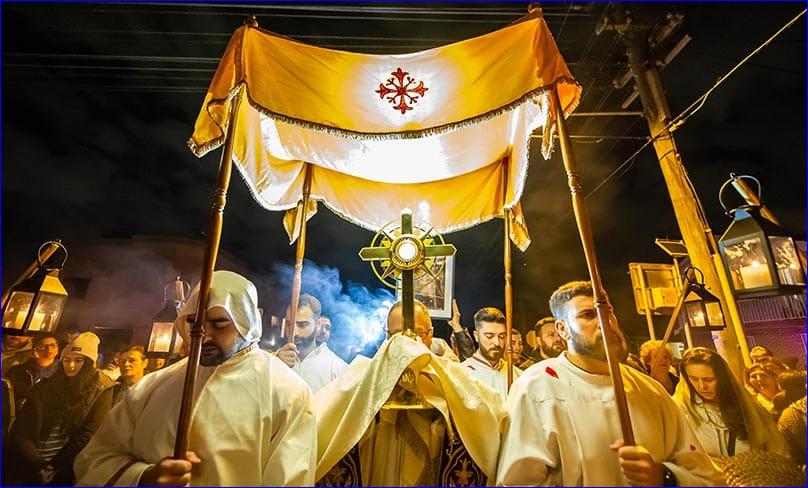


 Giovanni Portelli)
Giovanni Portelli)
However my brief had also included a request to do so within the Syriac tradition. Although I had never considered this before, I accepted the challenge with great curiosity and, with my research journey mapped out before me, I headed into new territory.
This was when I discovered just how influential St Ephrem -- the great Syriac Church Doctor -- had been in the formation of our Maronite Catholic Mass and the scriptural connections he made.
During the Fractioning, Sprinkling and Elevation of the Body and Blood of our Lord, the priest is praying while the congregation sings a hymn. This is after the Prayers of the Faithful (Intercessions), where the priest breaks the Body and uses a small piece to sprinkle the Blood on the Body. The priest says [from the Maronite Liturgical Book, the Qorbono]:
"We sign this Chalice of salvation and thanksgiving with the forgiving ember which glows with heavenly mysteries."
Here we may ask ourselves the question: what is an ember? We may be tempted to think of it merely as the spark that comes from the flame, but it is so much more.
The Merriam-Webster Dictionary actually defines an ember as "a glowing fragment (as of coal) from a fire".
So where does the reference to ember in the prayer come from? It comes from Saint Ephrem.
To further understand, we only need to read St Ephrem's Hymns on Faith and the excerpt below:
The Seraph did not touch the coal with his fingers. It touched only the mouth of Isaiah. [The Seraph] did not hold it, and [Isaiah] did not eat it. (Hymns on Faith, 10:10)
Saint Ephrem is referring to the vision the Prophet Isaiah had:
"Then flew one of the Seraphim to me, having in his hand a burning coal which he had taken with tongs from the altar. And he touched my mouth, and said: "Behold, this has touched your lips; your guilt is taken away, and your sin forgiven" (Isaiah 6:6--7).
But why did St Ephrem stress the fact that the Seraph did not touch the coal with his fingers and Isaiah did not eat it? There is one more line from St Ephrem that ties everything together:
But to us our Lord has given both (Hymns on Faith, 10:10).
St Ephrem is using typology to highlight that the burning ember is a type of the Eucharist, the Body and Blood, Soul and Divinity of our Lord Jesus Christ.
You see, back in Old Testament times people could not touch the Ark of the Covenant, as within it was the Spirit of God. The people were not worthy of touching our Lord; God's goodness was too much for our sinful nature (Numbers 4:15).
St Ephrem is stressing that we are able to eat the burning ember, i.e., the Eucharist! That means our nature has been elevated to such a degree that we can consume the Body and Blood, Soul and Divinity of our Lord Jesus Christ (don't forget that He is both God and Man) and live to tell the tale.
The Priest can hold the Body and Blood, Soul and Divinity of our Lord Jesus Christ (once again, literally God!) and once again live to tell the tale.
You could also say we have been divinised -- but that's an article all on its own, and for another edition.
That's why the Priest, before Communion, has the absolutely audacity to say:
"Holy Gifts for the holy, with perfection, purity and sanctity."
We have been made Holy so we can receive these Holy Gifts.
The Eucharist in light of the Syriac tradition really emphasises how our humanity has been elevated to another level. So next time you receive our Lord in Communion, I recommend and highly encourage everyone to really contemplate what you have just participated in.
Stefan Gerges is a student of Theology and Philosophy at the Catholic Institute of Sydney and Co-Founder of the podcast 'Casual Catholic Conversations'.

or register to post a comment.